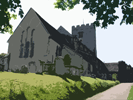

 |
 |
|---|
| About the Church:A Walk Around the Church | ||
If you are coming to visit our church please print out this page which takes you on a brief walk round the inside. Walk across to the Font (Norman) and look down the length of the Church. It will be seen that the chancel and nave are not in line, the former sloping markedly to the north-east. It has been suggested that this angle echoes the head of Christ on the cross, usually depicted drooping to His right. Such chancels are called weeping chancels. However, some think that a mistake was made when the original thirteenth century church (the chancel and east end of the north aisle) was extended in the fifteenth century. Notice the soaring clerestory of the 'Perpendicular' style nave and the kingposts and trussed rafter style roof. You will have entered through the North Porch (also fifteenth century). Notice the holy water stoup and the slots and metal hooks originally used for barring the door. On the wall in the North Aisle is a list of Rectors dating continuously from 1402. The earliest of these is Thomas Harlyng, commemorated in a fine brass next on the north wall. Further down the aisle on the right hand side is a plaque presented to the church by a school evacuated from London during the Second World War. Note the London Pride depicted on it. Two steps take you up to the Lady Chapel which formerly housed the organ but was restored in the late fifties. The work was carried out under the supervision of J Sebastian Comper whose 'signature' of a strawberry plant can be seen in both windows of this chapel. His ashes are buried under the slate plaque in the sanctuary floor before the beautiful 'English' altar designed by him to open up the chancel and give it a more traditional appearance. The chandeliers in the church are also of his design. The two carved wooden chairs in the chancel are seventeenth century as is probably the communion rail as well. The thirteenth century features of the church are the lancet widows in the chancel and the piscina for washing communion vessels. The large window in the south wall of the chancel is fifteenth century. It had been bricked up and was only revealed in 1879. The 'sedilia' or clergy seats are fourteenth century as is the window above the altar of the Blessed Sacrament chapel in the south aisle. The glass of this window was designed by William Glasby. Also in this chapel is another piscina and an aumbry for consecrated wine and wafers. A perpetually lighted lamp in the wall above is a reminder that the Blessed Sacrament is reserved. On the south wall of this aisle are brasses to the Mille family and the Memorials to the fallen of two World Wars. The South Porch is now a vestry. The gothic-style wooden screen to the tower was designed by Sir Ninian Comper (father of Sebastian) who also designed the children's window in the south aisle and the big wets window in the tower. Under the tower can be seen remains where a vaulted roof was projected but later abandoned. Over the cupboards on the south wall are the Royal Arms of King George III. History • The Windows • Plans and Pictures • Bell-Ringing
|
||
|
||